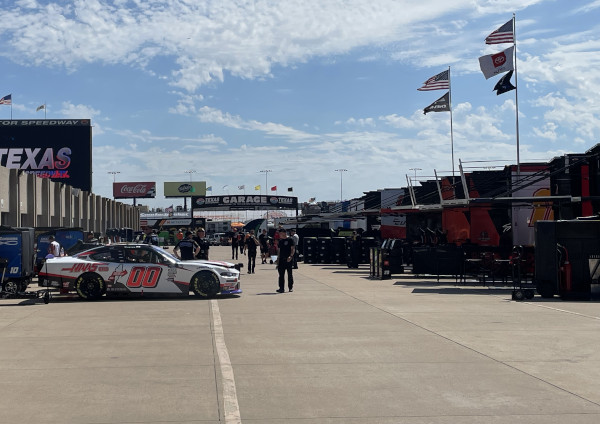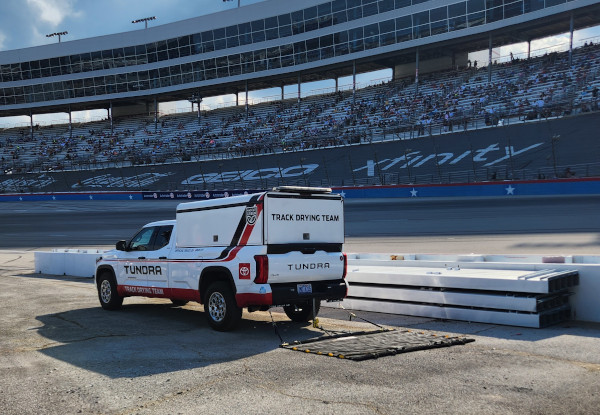FOD Operations
Motor Speedway Track Maintenance
While a stray piece of metal sitting in your driveway might give you a slow flat, that same foreign object on an auto speedway track during racing operations can cause a major incident. Let’s see the pros of race track maintenance for keeping them clean and safe from foreign object debris (FOD).
With a complex mixture of asphalt, pebbles, tires, rubber, liquids, heat, grip and momentum interacting with each other at high speed, the last thing you need is an unwelcome factor upsetting that delicate balance. The wrong item in the wrong place at the wrong time can literally spell disaster.
Suggested Resources
Need sweeping equipment? Check out our FOD-Razor® MotoSweep™, our PowerBar™ Magnet Sweepers, or our TracSweep® Pull Behind Rotary Sweepers for inspiration.

“Keeping the track as clean as possible is very important to our show,” says Shasta Speedway Promoter David Twyman. “It keeps the flying debris to a minimum, provides better grip and safety, and keeps fans and racers from getting the debris in their eyes and lungs.”
Your insurer may recommend conducting a safety audit, perhaps using a facility and event safety checklist such as this one from the Colorado Intergovernmental Risk Sharing Agency. It covers a wide range of concerns such as race track maintenance of smoothness, having adequate perimeter barriers and complying with building codes.
FOD Defined
Like any industrial environment that hosts precision equipment, every object present on a motor speedway track should have a reason for being where it is. A rock has no reason to be on a track. A bolt has no reason to be anywhere except on the housing to which it was originally bolted.
That is why the technical term for potentially hazardous items that are out of place is “foreign object debris”, or “FOD” for short. This can refer to any kind of manufactured or naturally-occurring object of any size, such as stray pieces of hardware, rubber pebbles, twigs, branches, or even an entire disabled automobile.
The companion term “foreign object damage”, (also shortened to “FOD”) refers to the damage that foreign object debris causes or might cause to a manufactured object – such as an automobile, track or barrier – or injury to a person. A third term, “foreign object elimination” (FOE) refers to efforts to remove foreign object debris from areas where it might cause foreign object damage.
As a critical safety and quality issue in the automotive, manufacturing, aviation, and aerospace sectors, a practical knowledge of FOD control will help you to maintain a safer and more efficient speedway track.
Oil and Water
Just like solid objects, liquids also qualify as FOD. Just as motor oil spilled over an engine can create electrical and fire hazards, liquids of any kind on a track can create navigational hazards. It doesn’t matter whether it is an accidental spill or a deliberate rinse of the track, if the liquid serves no purpose then it should be removed.
One popular and effective method is to lay down absorbent, inert material such as rice hull to soak up the liquid, then remove it from the speedway track, either with a sweeper or manually.
To take your efforts up a level, invest in a small fleet of sweepers and train a liquid removal team to manage the process. NASCAR has developed an intriguing post-rainfall system that uses one set of highly specialized blowers to push rainwater off the track, followed by a second set of blower trucks that use heat to evaporate the residue.
Pressure washing is perhaps the least popular method because it takes too much time and can damage the asphalt. However, it can be very useful when cleaning non-track surfaces. Also, never clean with caustic chemicals, which can dry out an asphalt surface.
Rubber
During a race, rubber is a driver’s best friend and worst enemy. The normal transfer of rubber between vehicle tire and speedway track during racing operations is dependent upon heat. If the tires are hotter than the track, then the tires transfer rubber to the track. Conversely, if the track is hotter than the tires, then the tires will collect rubber from the track.
This exchange actually improves the amount of “grip” that tires have on a track, at least during the earlier stages of a pavement’s service life. “Usually, when new pavement is laid down the grip level is lower and some drivers don’t realize this,” says Jose Martinez, Chief Driving Instructor of Porsche Club of America’s Puerto Rico Region, where the club rents a track to hold high-performance driver education events. “They usually find out the hard way on the first laps.”
The downside to rubber transfer is that, over time, the successive rubber layers will become subject to stress and start to crack, just like layers of old paint on a wall. This will create loose shards of rubber FOD. In addition, tires can create FOD directly. The excessive wear that comes with high-speed racing results in a tire throwing off rubber “marbles” that create direct hazards during a race.
“Hot, soft tires can pick the objects and shoot them out back as a projectile,” says Martinez. “When you add the incoming car speed plus the ejection speed of the object, these can cause damage to the incoming vehicle, usually on the windshield.”
Pro tip: Sometimes tires end up shredded during a race. Work with tire manufacturers to remove tire debris after the session has ended and comprehensive track cleanup can begin. The material composition of a racing tire qualifies as intellectual property, so it is in the manufacturer’s best interest to remove even the tiniest piece of shredded debris from the track shortly after a race, lest a competitor stumble across it first.
In fact, tire manufacturers’ representatives might already be present during your races, to collect and dispose of all used tires after the race has ended. The driver and crew might also be willing to participate in cleaning up their own tire shreds, which can offer clues as to why the tires were shredded in the first place.
Cracks and Chunks
An older speedway track can even be dangerous to itself. “Cracks in the asphalt are a major problem for us. We are currently using a product from Seals It to seal these cracks and fill small voids. A couple of other tracks have used it with great success,” says Twyman.
“That’s a big problem at our track, especially on the old section that feature a really coarse asphalt,” says Martinez. “When it breaks loose, it flies around or sits on the track, becoming another object that can be ejected by a car.”
This is why it is critical that you choose the most appropriate sweeper for your specific facility. No two tracks are designed the same or are in the same condition. Let’s take a look at your options.
Sweeper Considerations
Precision surfaces require precision equipment to keep them clean. You might be tempted to grab an inexpensive leaf blower and walk along the track blowing FOD onto the adjacent grounds. Keep in mind that whatever your blower can remove from the track, both natural winds and your racing vehicle’s wake flow can blow right back. While blowers have their uses, invest in a comprehensive solution that will permanently remove FOD from the racing environment.
“The rotating brush used at our track just moves the dirt and object from one area to another. The blower, also used at our track….is not strong enough to move everything and then does the same as the brush. The [FOD-Razor® Motor Sweeper] mat is the best option to pick significant objects from the track.” says Martinez. “Before taking the extra precautions, we would joke on how many windshields would break over the weekend.”

In fact, some tracks have learned how to combine blowers and sweepers into a powerful hybrid system. “One of the largest improvements we have found is less tire damage from small metal objects,” says Twyman. “We currently use a blower to clear the track and follow with [the FOD-Razor®] to clear the track and pit area. We and others who see it in action are amazed at the amount of debris cleaned up after the use of the blower.”
Choosing a sweeper to collect FOD from a racetrack involves special challenges not normally found on a surface street or airport runway.
Take banking, for instance. Speedway tracks often bank their turns to stabilize vehicles traveling at high speed so that they can maintain the proper forward movement. Sweepers, on the other hand, typically work at much lower speeds, typically anywhere from 5 mph to 35 mph, depending upon the type of sweeper and the conditions under which it operates.
So, banking can have the opposite effect on a sweeper, causing it to slide sideways, lose control of collected FOD, or otherwise operate less efficiently. It is vital to test a proposed sweeper on your banks, both left and right.
Changes in elevation can also affect performance, so test and up and down any hills as well. If any issues are observed ask the manufacturer’s rep if it can be mitigated. They have often been worked out in the past and might involve no more than a minor change in the sweeper’s configuration.
“We currently tow your device behind a quad in the reverse direction at a medium slow speed getting the best results,” says Twyman. “The time saved using this device will pay for itself in a season of racing. It will also save the racers money from flat tires.”
Another issue is sweeping during the actual race. A yellow flag offers only a short time frame for maintainers to enter the track and make any necessary sweeps. If racing standards, such as F1, require that mounted or towed sweepers travel in the direction of the race only, they won’t be able to back up or turn around.
Solutions? For very limited sweeping of a very limited area, have maintainers standing by armed with a portable backpack vacuum and a sturdy hand broom. To sweep larger areas, pre-position several sweepers at critical points around for race track maintenance.
Keeping your racetrack clean requires more than a worker with a broom. Form a sweeping operations team, discuss techniques with your colleagues at other tracks, consult with manufacturers’ reps, shop wisely, and enjoy a safe and profitable racing season.

